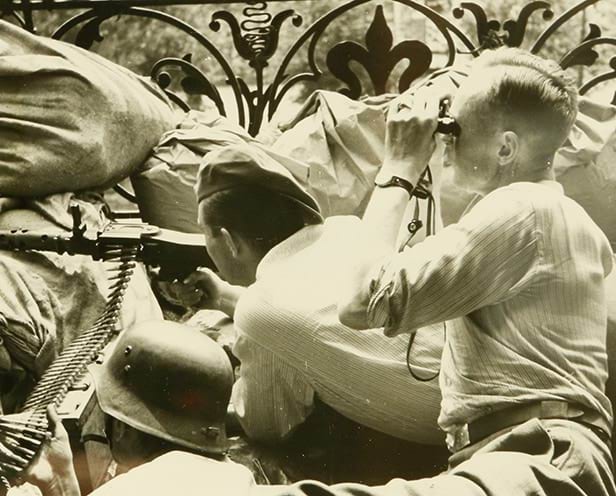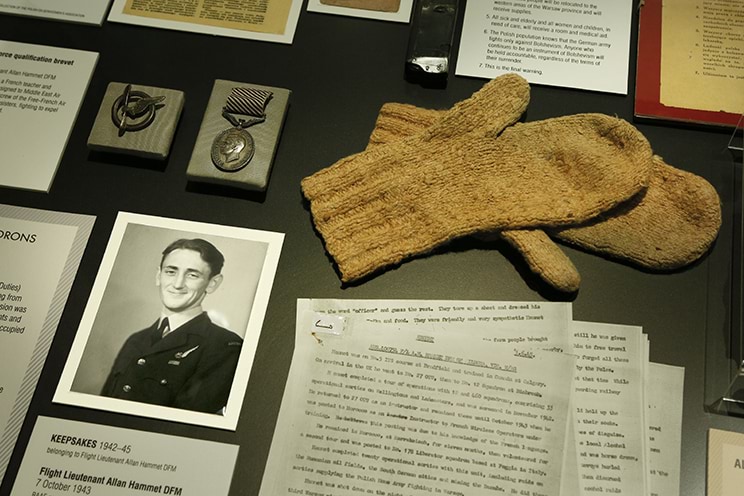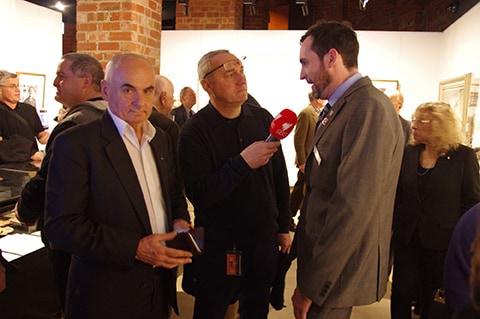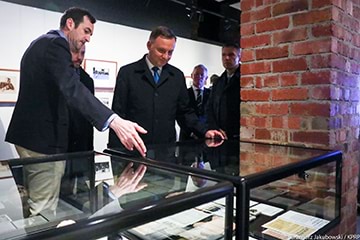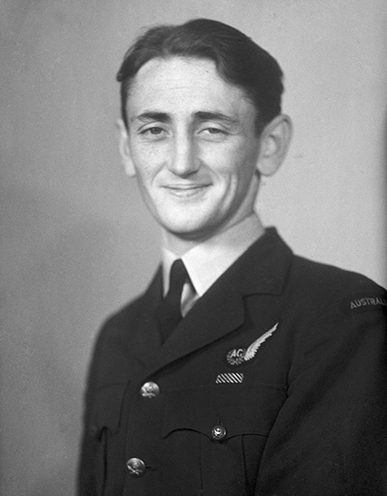
- Conflict:
- Second World War (1939-45)
- Service:
- Air Force
When Shrine Friend, Andrew Balcerzak, discovered a living link to a Second World War resistance hero, Allan Hammet, he was determined to share Hammet’s remarkable story.
When I first arrived in this country from Poland in December 1972, I had high hopes of meeting Australia’s ‘Golden Girl’, multiple Olympic gold medalist Shane Gould. We were the same age–16–and, like any teenager in a new city, I was keen to make friends. Our paths never did cross but I considered myself lucky regardless. My family was among a fortunate few to have extracted itself from the dismal communist state our homeland had become.
Poland’s nightmare began in September 1939 when it was invaded by Nazi Germany and the Soviet Union. Dividing the country between them, the hostile powers sought to subjugate Poles and eradicate their culture. War between the erstwhile ‘allies’ followed in June 1941 and Poland, trapped between the two, paid dearly—even after the defeat of Nazism. Six years of war and occupation cost the lives of six million Polish citizens, over 20 percent of the pre-war population. Ninety percent of these people were civilians. Members of my own extended family counted among the dead.
Against this miserable backdrop, the reader may appreciate how stories of Polish resistance during the war inspired Polish-Australian families like my own. The example of these brave men and women gave us hope that our homeland might one day be free again. After living in my adopted country for a few years, I came to appreciate another group of heroes, the Australian servicemen who risked their lives trying to help Poland during those terrible years.
My passionate interest in the wartime history of Poland led directly to my association with the Shrine of Remembrance.
In 2016–17, I assisted the Shrine in the development of a special exhibition resistance: Australians and the European Underground 1939–45. The exhibition told the stories of Australian service men and women who aided, and were in turn aided by, the many resistance groups in Nazi-occupied Europe. My deep knowledge of the Polish Home Army, the most significant Polish resistance movement, allowed me to provide the Shrine with many relevant stories and contacts. One of these stories was that of wireless operator, Flight Lieutenant Allan Hunter Hammet DFM.
I knew of the wartime exploits of Allan Hammet long before I learnt that one of my fellow parishioners at St Thomas Aquinas Catholic Church in South Yarra, shared his surname. Asking Michael Hammet one day if he was any relation to Allan, I was delighted to discover that I had met the son of one of my heroes. This stroke of serendipity ensured that a small precious collection of relics pertaining to Allan’s war service would feature in the exhibition—and Michael’s father’s story could be told. The items have since been donated to the Shrine by Michael and form part of the permanent collection.
Allan grew up in Red Cliffs, near Mildura, Victoria and joined the Royal Australian Air Force (RAAF) in October 1940, whereupon he undertook training in Canada under the Empire Air Training Scheme. Allan beat very considerable odds when he survived a full ‘tour’ of 30 combat missions with celebrated Australian bomber squadron, No. 460, RAAF. His tour, running between August 1942 and January 1943, fell during one of the most dangerous periods for Royal Air Force (RAF) Bomber Command—a service which absorbed two percent of Australian enlistments during the Second World War but accounted for 20 percent of all Australian combat deaths.
On a December 1942 raid on Duisberg, Germany, Allan’s aircraft’s wireless and navigational apparatus were seriously damaged by enemy fire. Allan, displaying ‘high courage, efficiency and devotion’, improvised communications, allowing the pilot and navigator to get them safely home to base. Allan received a Distinguished Flying Medal (DFM) in March 1943. A posting to Morocco followed, where he trained Free-French aircrews for several months before embarking on a second tour in July 1944. His new ‘Special Duties’ squadron, No. 178 Squadron, RAF, flew missions out of Foggia, Italy where they dropped arms and other supplies to resistance groups in the Balkans.
On 1 August 1944, the Polish Home Army launched a full-scale insurrection in Warsaw. The Poles hoped to oust the Germans before the arrival of the advancing Soviet Red Army. No. 178 was one of five Allied special duties squadrons which, collectively, flew 182 sorties in support of the 63-day Warsaw Uprising. The distance to Warsaw was much further than earlier supply-drop missions and brought the crews over the very heart of the Reich. The drops, executed at low speed and very low altitude, were among the most dangerous missions of the war. A total of 35 crews would be lost—an attrition rate of almost 20 percent.
On the night of 16–17 August 1944, Allan’s aircraft, Liberator KG-933, was attacked by a German night-fighter in the skies near Cracow, southern Poland. Sustaining shrapnel wounds to his side, hands and lower limbs, Allan nonetheless succeeded in baling-out of the doomed aircraft. Two British comrades—air-gunner, Sergeant F W Helme, and flight engineer, Sergeant L J Blunt—followed. The pilot, Flight Lieutenant William Wright; navigator, Squadron Leader John Liversidge and air-gunner, Flight Sergeant John Clarke, however, were killed when the aircraft crashed over the Cracow suburb of Podgórze. Helme and Blunt would later die in German captivity. Allan, alone, would survive.
The sacrifice of Liberator KG-933 has never been forgotten in Cracow. The Polish Aviation Seniors Association unveiled a plaque dedicated to the crew in 1986 on the wall of a factory where fragments of the burning plane fell. The factory, owned by one-time Nazi industrialist and latter-day ‘Righteous Gentile’, Oskar Schindler was immortalised in the 1993 film Schindler’s List. Other debris, landing nearby on the banks of the river Vistula, led to it being renamed ‘Allied Aviators Boulevard’ in 2014. A large obelisk and a mural, paid for by public subscription, were added in 2018.
I encountered the depth of this gratitude first-hand in October last year, when I visited Cracow to meet the individuals and organisations responsible for the memorials. My hosts included Mr. Paweł Kubisztal, President of Podgórze Association, Colonel Stanisław Wojdyła President of the Cracow Polish Aviation Seniors Association and Dr Krzysztof Wielgus, a Cracow Polytechnic academic and member of the Committee for the Restoration of Historic Monuments in Cracow.
Dr Wielgus took me on a walking tour of the sites associated with the crash. He explained:
My own father witnessed the crash. I can’t stress how significant the event was for him. In August 1944 the people of Poland were utterly isolated and exhausted by nearly six years of cruel German occupation. The sight of the plane burning and breaking up in the sky was like a sign from heaven.
When I asked how the destruction of a friendly aircraft could be viewed thus, Wielgus continued:
It was a sign that at long last their prayers had been answered: the Allies were nearby and were prepared to risk so much to help the Home Army. It gave people hope. They saw that large numbers of Allied aircraft were making the trip to Warsaw and believed, mistakenly as it turned out, that their suffering would soon be at an end.
The walking tour, entitled ‘Liberator over Zabłocie’, is conducted annually on the eve of the anniversary of the crash and ends with the lighting of candles and laying of flowers in remembrance of the crew. The tour continues to grow in popularity and attracts hundreds of locals and tourists.
Returning to our story, back in August 1944, Allan Hammet’s difficulties were only beginning. Coming down in a ploughed field some distance from the crash, Allan was unsure whether he was in occupied Poland or pro-Nazi Slovakia and so he headed due-north, hoping to contact the Polish Home Army. For two days, he travelled by night and sheltered in the forest by day. He ate raw potatoes and tried to stem the bleeding of his many wounds with bandages. Reaching the limit of his endurance, Allan approached an isolated farmhouse. The woman who lived there sent word to the Home Army. A local doctor, Kornel Jan Fojcik, tended Allan’s wounds, almost certainly saving Allan’s life.
In the weeks that followed, Allan was passed from one safehouse to another. He eventually arrived at the Swiecice Estate of the English-speaking Jadwiga Wielowieyska (nee Suchodolska). Jadwiga’s first husband, a Polish army officer, Jan Wielowieyski had been killed in action on 10 September 1939 but Jadwiga continued to resist the Germans, hiding fugitives and providing material support for Home Army fighters. Allan would later recall tense days when partisans hid on the estate at the very time German troops came to requisition food. As Allan recovered from his wounds, his admiration for the Polish resistance and his beautiful hostess grew to the point where he felt compelled to fight as a Home Army partisan and to ask Jadwiga for her hand in marriage.
Allan undertook weapons training with the partisans and was issued with false identification and medical documents in the name of Stefan Erbe—a professional railway photographer, rendered deaf and dumb after a railway accident. His partisan unit comprised 200 trained fighters, men and women, quartered in huts and underground shelters in a forest 70 kilometres north of Cracow.
The motley crew were armed with small arms provided by RAF air drops or captured from their German and Ukrainian enemies. Five British servicemen, escapees from German prisoner of war camps, joined the unit and the Home Army dutifully got word back to England that Allan and the other men were alive. It was news for which Allan’s parents had long been waiting.
Allan’s first action came on 20 September 1944 when a detachment of his unit raided a railway station with the aim of capturing German uniforms and weapons. The raid was successful, and the detachment escaped unscathed. A week later they attacked a supply convoy carrying sugar destined for the German Army. The guard was killed, the sugar seized and distributed to the local population. Allan explained in a later report that ‘owing to the complete unity of the Polish attitude to the Germans, the partisans had all the information necessary for timing their raids.’ This massive strategic advantage, was ruthlessly, if selectively, exploited by the partisans.
The Germans redoubled their efforts to eliminate the partisans and in October a German spotter plane, flying at treetop height over the forest, spotted the group. The pilot alerted his headquarters by radio before his plane was brought down by small arms fire. A Ukrainian punitive detachment sent by the Germans caught up with the partisans near Swiecice. The ensuing two-hour battle was particularly fierce and eight of their number were killed, including two of the five British escapees. Nine Ukrainians died and many more were wounded.
Advancing Soviet Red Army troops arrived in Allan’s sector in January 1945. Allan and the surviving English soldiers, whom he described as magnificent fighters, were transferred to a Soviet Brigade Headquarters at Zloty. The party walked 30 kilometres to Miechow and from there another 100 kilometres to Czestochowa. Here the Soviets had organised a rendezvous point for liberated and escaped Allied prisoners of war. In February 1945, the British Mission in Moscow, by agreement with the Soviets, placed Allan in command of around 900 British, Australian and South African troops, ordering him to lead the men to the Black Sea port of Odessa. Jadwiga and her young daughter Rosmarie went with them.
Hammet recalled that the Soviet troops were friendly, but had little food or supplies to offer his group. Allan’s appeals to Polish locals en route were successful, however. ‘It is thanks to the kindness of these Poles that the troops kept going, most of the time on potatoes’. At Cracow the party was joined by another thirty ex-POWs and from there travelled by truck, train and foot, reaching Odessa three weeks later. Allan was by this time exhausted, ill and dangerously emaciated. The group boarded a ship, SS Moreton, and was repatriated to England via the Middle East. Allan received medical care for his various war-related injuries and illnesses and he, Jadwiga and Rosmarie were repatriated to Australia soon after. In Mildura, the couple had twin boys, Peter and Michael, born in November 1946.
In the years to come Allan worked a variety of jobs—woodcutter, fisherman, cook and estate agent—in Mildura and Melbourne. Listless, traumatised, and craving adventure, he struggled to settle down and his marriage eventually failed. He would marry twice more.
By the late-60s Allan had risen to become the principal of his real estate firm. In the 1970s he and his then wife Lorraine, relocated to Pambula on the New South Wales south coast. He continued to work until his death aged 60 on 29 October 1981.
I look back proudly on my role in helping the Shrine bring such a remarkable story to light. I would encourage other Shrine Friends to take stock of the war stories they have encountered in their own lives—those of their family and friends—and think on how they might share them with the community.
Author: Andrew Balcerzak
Updated

